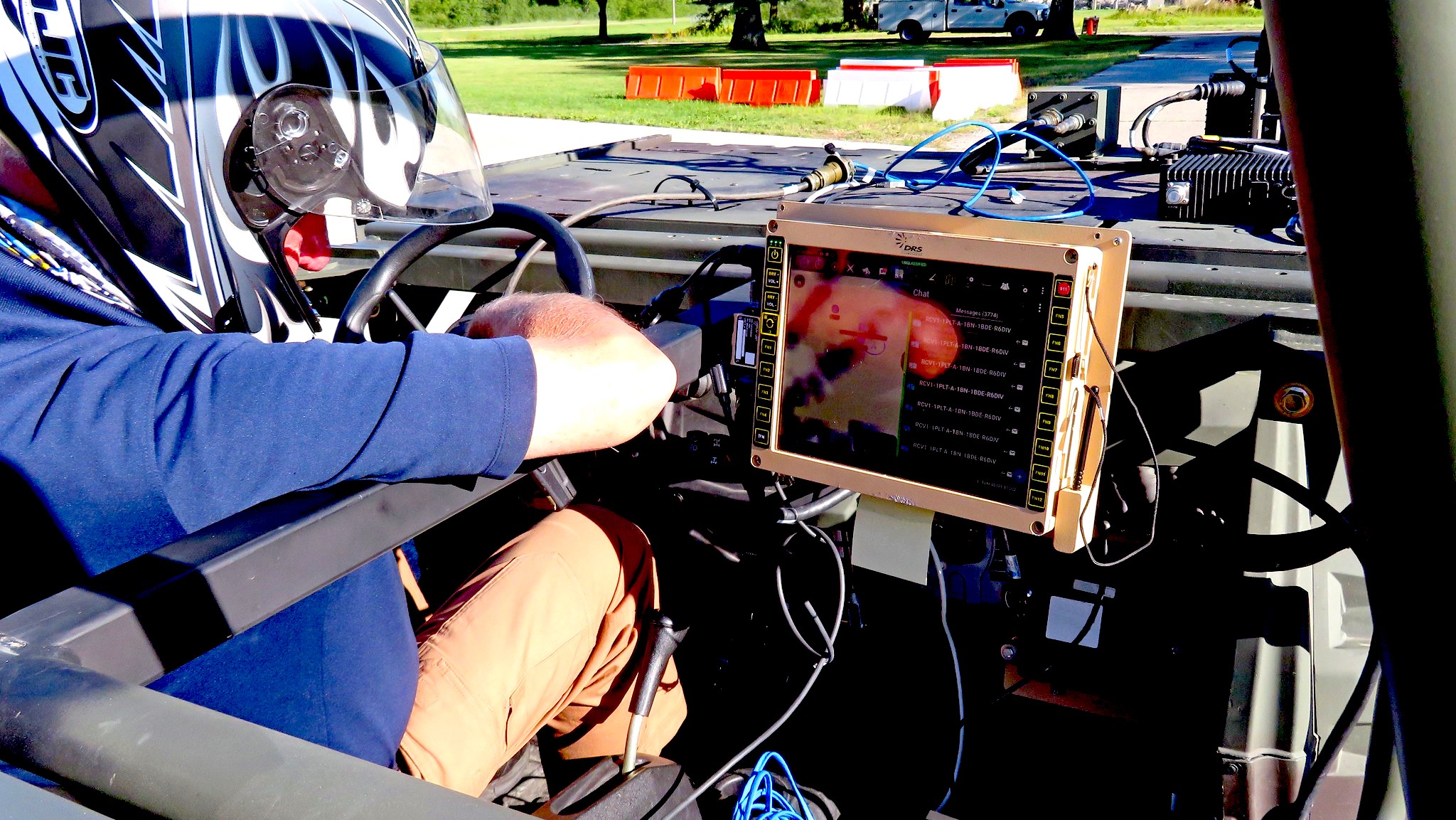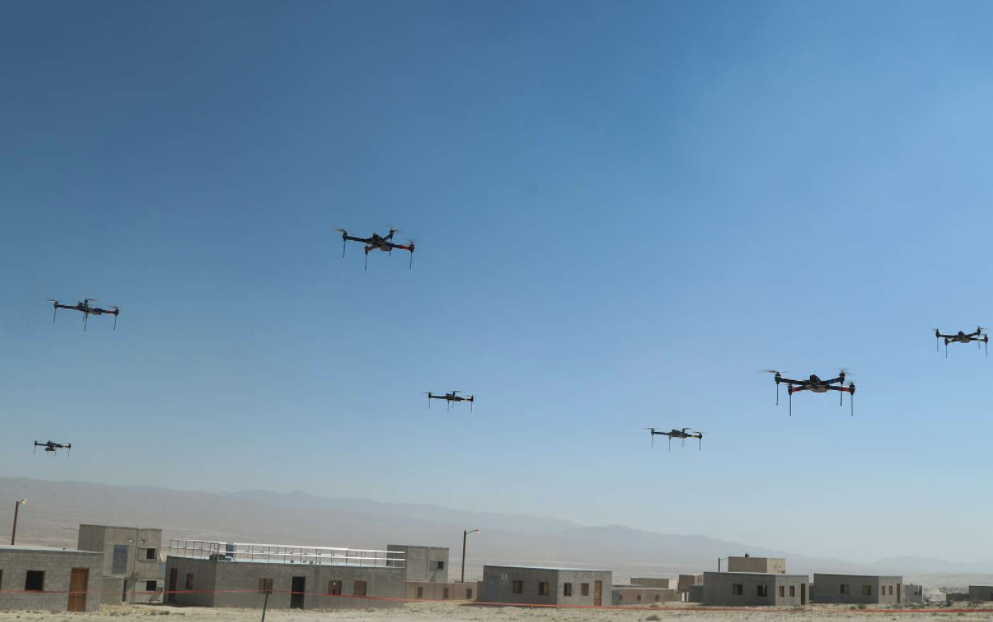Artificial intelligence, lethal autonomous weapons, hypersonic missiles, cyber battles: The Arms Control Association rings alarm bells over the rush to develop these and other advanced military technologies.

Vehicle robotics testing in Michigan, September 2020. (U.S. Army Combat Capabilities Development Command, Flickr)
By Brett Wilkins
Common Dreams
Emerging technologies including artificial intelligence, lethal autonomous weapons systems and hypersonic missiles pose a potentially existential threat that underscores the imperative of arms control measures to slow the pace of weaponization, according to a new report published Tuesday.
The Arms Control Association report — Assessing the Dangers: Emerging Military Technologies and Nuclear (In)Stability — “unpacks the concept of ’emerging technologies’ and summarizes the debate over their utilization for military purposes and their impact on strategic stability.”
The publication notes that the world’s military powers “have sought to exploit advanced technologiesv — artificial intelligence, autonomy, cyber, and hypersonics, among others — to gain battlefield advantages” but warns too little has been said about the dangers these weapons represent.
“Some officials and analysts posit that such emerging technologies will revolutionize warfare, making obsolete the weapons and strategies of the past,” the report states. “Yet, before the major powers move quickly ahead with the weaponization of these technologies, there is a great need for policymakers, defense officials, diplomats, journalists, educators, and members of the public to better understand the unintended and hazardous outcomes of these technologies.”
Lethal autonomous weapons systems — defined by the Campaign to Stop Killer Robots as armaments that operate independent of “meaningful human control” — are being developed by nations including China, Israel, Russia, South Korea, the United Kingdom, and the United States.
The U.S. Air Force’s sci-fi-sounding Skyborg Autonomous Control System, currently under development, is, according to the report, “intended to control multiple drone aircraft simultaneously and allow them to operate in ‘swarms,’ coordinating their actions with one another with minimum oversight by human pilots.”

Swarm of 40 drones through a mock battle at the National Training Center in San Bernardino, California, May 8, 2019. (U.S. Army, James Newsome)
“Although the rapid deployment of such systems appears highly desirable to many military officials, their development has generated considerable alarm among diplomats, human rights campaigners, arms control advocates, and others who fear that deploying fully autonomous weapons in battle would severely reduce human oversight of combat operations, possibly resulting in violations of international law, and could weaken barriers that restrain escalation from conventional to nuclear war,” the report notes.
Support CN’s
Winter Fund Drive!
The latter half of the 20th century witnessed numerous nuclear close calls, many based on misinterpretations, limitations, or outright failures of technology. While technologies like artificial intelligence (AI) are often touted as immune to human fallibility, the research suggests that such claims and hubris could have deadly and unforeseen consequences.
“An increased reliance on AI could lead to new types of catastrophic mistakes,” a 2018 report by the Rand Corporation warned. “There may be pressure to use it before it is technologically mature; it may be susceptible to adversarial subversion; or adversaries may believe that the AI is more capable than it is, leading them to make catastrophic mistakes.”
While the Pentagon in 2020 adopted five principles for what it calls the “ethical” use of AI, many ethicists argue the only safe course of action is a total ban on lethal autonomous weapons systems.
Hypersonic Missiles

A Kh-47M2 Kinzhal being carried by a Mikoyan MiG-31K interceptor on display in 2018 Moscow Victory Day Parades. (Kremlin.ru, CC BY 4.0, Wikimedia Commons)
Hypersonic missiles, which can travel at speeds of Mach 5 — five times the speed of sound — or faster, are now part of at least the U.S., Chinese and Russian arsenals.
Last year, Russian officials acknowledged deploying Kinzhal hypersonic missiles three times during the country’s invasion of Ukraine in what is believed to be the first use of such weapons in combat. In recent years, China has tested multiple hypersonic missile variants using specially designed high-altitude balloons. Countries including Australia, France, India, Japan, Germany, Iran and North Korea are also developing hypersonic weapons.
The report also warns of the escalatory potential of cyberwarfare and automated battlefield decision-making.
“As was the case during World Wars I and II, the major powers are rushing ahead with the weaponization of advanced technologies before they have fully considered — let alone attempted to mitigate — the consequences of doing so, including the risk of significant civilian casualties and the accidental or inadvertent escalation of conflict,” Michael Klare, a board member at the Arms Control Association and the report’s lead author, said in a statement.
“While the media and the U.S. Congress have devoted much attention to the purported benefits of exploiting cutting-edge technologies for military use, far less has been said about the risks involved,” he added.
Arms Control Agreements

Cyber battle space research, April 2021. (U.S. Army Combat Capabilities Development Command, Flickr)
The report asserts that bilateral and multilateral agreements between countries that “appreciate the escalatory risks posed by the weaponization of emerging technologies” are critical to minimizing those dangers.
“As an example of a useful first step, the leaders of the major nuclear powers could jointly pledge to eschew cyberattacks” against each other’s command, control, communications, and information (C3I) systems, the report states. A code of conduct governing the military use of artificial intelligence based on the Pentagon’s AI ethics principles is also recommended.
“If the major powers are prepared to discuss binding restrictions on the military use of destabilizing technologies, certain priorities take precedence,” the paper argues. “The first would be an agreement or agreements prohibiting attacks on the nuclear C3I systems of another state by cyberspace means or via missile strikes, especially hypersonic strikes.”
“Another top priority would be measures aimed at preventing swarm attacks by autonomous weapons on another state’s missile submarines, mobile ICBMs, and other second-strike retaliatory systems,” the report continues, referring to intercontinental ballistic missiles. “Strict limitations should be imposed on the use of automated decision-support systems with the capacity to inform or initiate major battlefield decisions, including a requirement that humans exercise ultimate control over such devices.”
“Without the adoption of measures such as these, cutting-edge technologies will be converted into military systems at an ever-increasing tempo, and the dangers to world security will grow apace,” the publication concluded. “A more thorough understanding of the distinctive threats to strategic stability posed by these technologies and the imposition of restraints on their military use would go a long way toward reducing the risks of Armageddon.”
Brett Wilkins is a staff writer for Common Dreams.
This article is from Common Dreams.
The views expressed in this article and may or may not reflect those of Consortium News.
Support CN’s
Winter Fund Drive!
Donate securely by credit card or check by clicking the red button:


So long as “reducing the risks of Armageddon” continue to face the temptation for profiteering from increasing the arm-and-get-ons like in Ukraine and perhaps Taiwan and periodically usher in deal-ditching elites like Trump the arms control imperative involving emerging technologies would be non-starters and stay irrelevent to modern life. Armageddon vs. arm-and-get-on are a Catch -22 situation as long as GREED rules our political and economic elites, period !
Some countries are less principled than others – most are not principled at all, and these are the ones who will use every dirty trick and advantage they can think up. Those few that are principled will be able to retain their honour in defeat. They won’t die of shame.
I don’t believe for a moment that any agreements or treaties will be adhered to. Certainly not by any country in the collective west.
High tech military weapons are one thing—truly a sad thing—–But the real thing, and the sad thing–seems to be that are no humans who are truly competent to use those weapons.
Humanity is on track to weaponize itself into extinction.
Off topic but pertinent to “advanced” technology, the latest (to me) harebrained idea, is this attempt to solve our climate breakdown:
“A solution to the climate crisis: mining the moon, researchers say”
“Proponents of a “moonshot” idea to deal with global heating have been handed a new, very literal, interpretation by researchers who have proposed firing plumes of moon dust from a gun into space in order to deflect the sun’s rays away from Earth.
The seemingly outlandish concept, outlined in a new research paper, would involve creating a “solar shield” in space by mining the moon of millions of tons of its dust and then “ballistically eject[ing]” it to a point in space about 1m miles from Earth, where the floating grains would partially block incoming sunlight.”
As science progresses, human survivability shrinks. It is just a matter of time — a very short period of time. Ta,ta.
“The development of full artificial intelligence could spell the end of the human race”. Stephen Hawking.
Given the recent experiences Russia has had with the fragility of agreements with the West it is somewhat difficult to conceive of an arms control mechanism which will be anything short of hair-trigger MAD with a permanent doomsday clock set at about one second before midnight – unless eventually the world decides that such a situation is not conducive to any form of reasonable survival.
Thank you, Brett.
War is insanity. Building war weapons, likewise.
It is also possible to access electric circuits in homes, buildings, stores, and streets to cause a circuit to hyperexcite and shock those nearby.
I’m waiting 4 braggadocio from MIC mfrs: “Look how many American JOBS we generate!”
True enough I suppose… But… Less likely Wage Workers receive Bunker Access!
The only “bunker” they’ll get, is the “Archie” type. LOL
AI is created by humans and the idea that any creation can be less fallible than its creator is preposterous.
“AI is created by humans…”
Correct and hence there is no artificial intelligence, just a myth created to deflect blame and posit increased productivity instead of increased garbage in/garbage out of the Sorceror’s Apprentice in pursuit of “magic bullets”.
“There may be pressure to use it before it is technologically mature;”
AI will never be technologically mature because anything that has reached maturity will already be obsolete.
“AI will never be technologically mature because anything that has reached maturity will already be obsolete.”
“AI is created by humans…” and hence Artificial Intelligence does not exist.
Change is a constant whose variables include but are not limited to trajectory and velocity not linear but lateral, and hence “maturity” is never attained, merely varying degrees of obsolescence as a function of human intelligence.